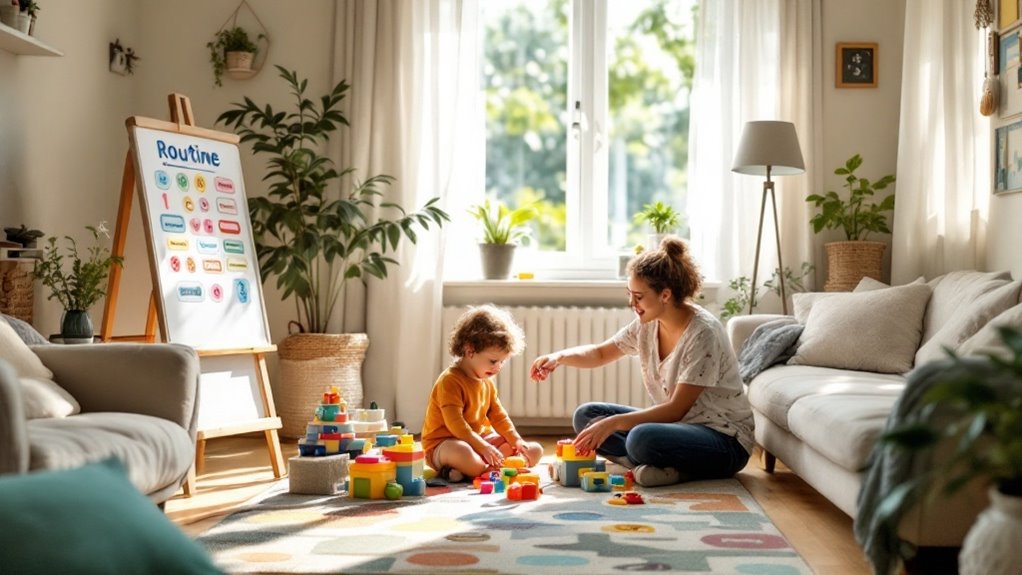Building a routine can really help your family thrive in ABA therapy. Start by creating a consistent daily schedule that includes therapy sessions, meals, and playtime. Make it fun by involving your kids in the planning—ask for their input on activities they enjoy. Visual supports like schedules and behavior charts can make daily tasks clearer and more engaging. Remember, flexibility is key; life happens, and routines should adapt to your family's needs. By celebrating small victories, you'll keep motivation high. Stick around to explore more tips that can make your routine feel even more manageable and fun.
Key Takeaways
- Establish consistent daily schedules that include therapy sessions, meals, and playtime to reduce anxiety and promote engagement.
- Incorporate visual supports like schedules and behavior charts to make daily tasks tangible and encourage positive behavior.
- Involve your child in planning routines to enhance their excitement and sense of ownership over their progress.
- Maintain flexibility in routines to adapt to unexpected challenges and changes in energy levels or family events.
- Celebrate small victories to motivate adherence to routines and reinforce the skills learned during ABA therapy.
Understanding ABA Therapy Benefits

Understanding the benefits of ABA therapy can be a game changer for your child. You might've noticed some challenges your child faces, and ABA therapy offers practical solutions that can lead to significant behavioral improvements.
Imagine your child learning new skills and becoming more independent—ABA therapy focuses on that precise growth.
As a parent, your involvement is essential. You're not just a spectator; you're an active participant in your child's journey. By engaging in the therapy process, you help reinforce the skills being taught.
You'll learn techniques to implement at home, which can create a seamless shift between therapy sessions and daily life.
Skill development isn't just about academics or social skills; it also encompasses daily living tasks. Whether it's learning to communicate needs effectively or mastering self-care routines, each small victory contributes to your child's confidence and overall well-being.
Establishing Consistent Daily Schedules
Creating a routine for your child can make all the difference in their ABA therapy journey. Consistent daily schedules help your child know what to expect, reducing anxiety and promoting engagement. Start by identifying key activities like therapy sessions, meals, playtime, and bedtime. By establishing a clear timetable, you'll enhance your time management skills, ensuring each day flows smoothly.
Involve the whole family in this process. Discuss the routine together and assign responsibilities. For instance, maybe one family member can help with breakfast while another handles the evening wind-down. When everyone participates, your child sees that the routine is a team effort, making it feel more stable and supportive.
Don't forget to be flexible. Life happens, and unexpected changes may arise. If something disrupts the schedule, calmly adapt and explain it to your child. This teaches them resilience and helps them understand that routines can be adjusted without losing their structure.
Finally, celebrate small victories! Acknowledge when your child follows the routine well. This positive reinforcement encourages them to engage further, making their ABA therapy journey even more effective.
Incorporating Visual Supports

Visual supports can be a game-changer in your child's ABA therapy routine. They help make abstract concepts tangible, making it easier for your child to understand expectations and stay on task. Consider using visual schedules to outline daily activities, or behavior charts to track progress and achievements. These tools not only provide structure but also empower your child, giving them a sense of control over their routine.
Here's a simple way to incorporate these visual supports:
| Type of Support | Purpose |
|---|---|
| Visual Schedules | Outline daily tasks and shifts |
| Behavior Charts | Track progress and reinforce positive behavior |
| Reward Systems | Motivate with visual incentives |
Creating a visual schedule can be as simple as using pictures or icons that represent each activity. Behavior charts can include stickers or stars for each completed task, reinforcing your child's accomplishments. By integrating these visual supports, you'll create an environment where your child feels more secure, engaged, and enthusiastic to participate in their therapy routine.
Involving Your Child in Planning
Involving your child in planning their ABA therapy routine can transform their experience from passive to active participation. When you engage them in the process, it not only empowers them but also makes the routine more enjoyable.
Start by sitting down together and discussing their goals. Ask them what they want to learn or improve. This can spark excitement and give them ownership over their progress.
Next, brainstorm activity choices that align with those goals. Let your child suggest fun activities they'd like to try—whether it's games, crafts, or outdoor play. This encourages creativity and guarantees they're genuinely interested in what they're doing. You might be surprised by their enthusiasm once they see their ideas being implemented!
As you finalize the routine, encourage your child to reflect on how they feel about each activity. This not only reinforces their involvement but also helps them develop critical thinking skills around their learning process.
Adjusting Routines as Needed

Once you've established a routine with your child, it's important to remember that flexibility is key. Life can throw unexpected challenges your way, and your routine may need adjustments to meet your family's needs. Embracing flexible planning means being open to change and recognizing when it's time for a routine evaluation.
For example, if your child's energy levels fluctuate or if new therapies are introduced, don't hesitate to tweak the schedule. Here's a simple way to visualize potential adjustments:
| Scenario | Current Routine | Adjusted Plan |
|---|---|---|
| Child has a bad day | Stick to the full routine | Shorten activities |
| New therapy on weekends | No change in routine | Add therapy to the weekend |
| Family event arises | Regular schedule | Shift activities to accommodate |
| Seasonal changes affect mood | Standard routine | Introduce outdoor time |
Conclusion
Building a routine for your child in ABA therapy can truly make a difference in their progress and well-being. By staying consistent and flexible, you're setting them up for success. Remember, it's all about creating an environment where they thrive. So, what steps will you take today to make your routine a little more supportive? Embrace the journey, involve your child, and watch as they blossom through the structure you create together.

